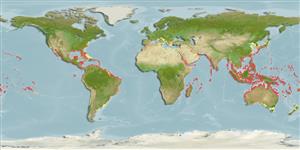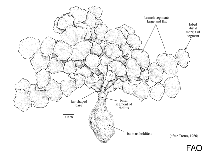Halimeda opuntia (Linnaeus) J.V. Lamouroux
Prostrate sea cactus| Native range | All suitable habitat | Point map | Year 2050 |

|
| This map was computer-generated and has not yet been reviewed. |
| Halimeda opuntia AquaMaps Data sources: GBIF OBIS |
muatnaik fotos/gambar
imej Google | No image available for this species;
drawing shows typical species in Halimedaceae.
imej Google | No image available for this species;
drawing shows typical species in Halimedaceae.
Classification / Names Common names | Synonyms | CoL | ITIS | WoRMS
| Bryopsidales | Halimedaceae
Environment: milieu / climate zone / depth range / distribution range Ekologi
; kisaran kedalaman 0 - 25 m (Ref. 83908). Tropical
Penyebaran Negara-negara | Daerah-daerah FAO | Ecosystems | Kemunculan | Introduksi
Indo-Pacific, Atlantic Ocean and the Mediterranean.
Length at first maturity / Size / Weight / umur
Maturity: Lm ? range ? - ? cm
deskripsi pendek Morfologi
Thalli form greenish to cream amorphous clumps, attached by rhizoids at various points where segments get in contact with the substrate. Branches composed of moderately calcified flat segments with a distinct central rib, generally reniform to flabellate with the upper margin entire, sinuate to deeply lobed, 3 to 8 mm high, 4 to 10 mm wide, and 0.5 to 7 mm thick. Cortex consisting of 5 layers of utricles formed by repeated dichotomies from the medullary filaments; outermost utricles adhere slightly after decalcification, hexagonal in surface view, 23 by 40 to 50 μm in transverse section; secondary utricles about 17 μm wide. Central medullary filaments extend along the segments, terete and trichotomously branched, with evident constrictions at a short distance above the point of branching. Amorphous clumps up to 15 cm in diameter (Ref. 80758).
Not utilized commercially, although found to be a source of growth regulators such as auxin, gibberellin, cytokinin; has antibacterial and antifungal properties (Ref. 80758). Grows in the lower intertidal zone of coral reefs or on dead corals below the low-tide mark in calm shallow waters (Ref. 80758).
Life cycle and mating behavior Kematangan | Reproduksi, perkembang biakan | Pemijahan | telur-telur | Fecundity | Larva
rujukan utama
Acuan | Koordinator | mitra
Guiry, M.D. and G.M. Guiry. 2009. (Ref. 80701)
Status IUCN Red List (Ref. 130435)
status CITES (Ref. 108899)
Not Evaluated
CMS (Ref. 116361)
Not Evaluated
ancaman kepada manusia
penggunaan manusia
| FishSource |
Alat, peralatan
informasi lanjut
Nama-nama umum
Sinonim (persamaan)
Pemangsa
Reproduksi, perkembang biakan
Kematangan
Pemijahan
Fecundity
telur-telur
pekembangan telor
Sinonim (persamaan)
Pemangsa
Reproduksi, perkembang biakan
Kematangan
Pemijahan
Fecundity
telur-telur
pekembangan telor
Sumber internet
BHL | BOLD Systems | CISTI | DiscoverLife | FAO(Publication : search) | Fishipedia | GenBank (genom, Nukleotida) | GloBI | Gomexsi | Google Books | Google Scholar | Google | PubMed | AlgaeBase | Tree of Life | Wikipedia (pergi, Cari) | Zoological Record
Estimates based on models
Preferred temperature
(Ref. 115969): 24.6 - 29.2, mean 28 (based on 4250 cells).



